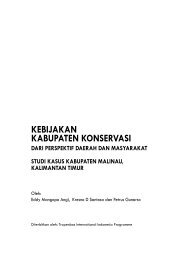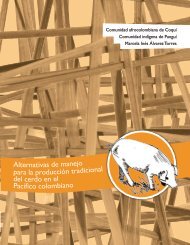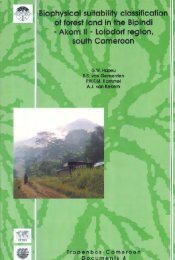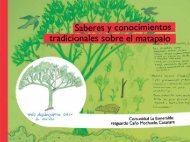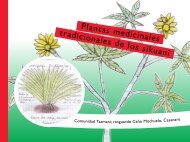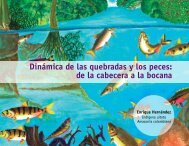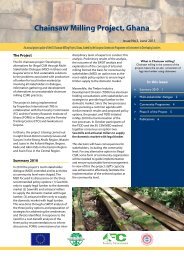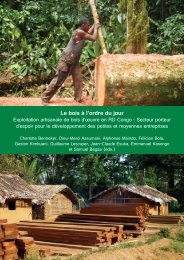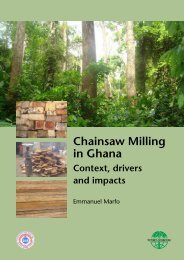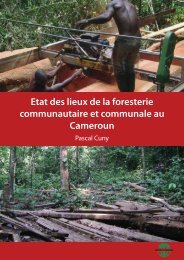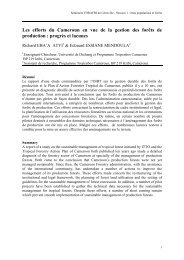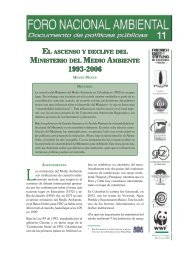Download the publication - Tropenbos International
Download the publication - Tropenbos International
Download the publication - Tropenbos International
You also want an ePaper? Increase the reach of your titles
YUMPU automatically turns print PDFs into web optimized ePapers that Google loves.
Central African tropical rain forest structure and composition<br />
and soil characteristics such as soil types, composition, pH (H20), electricity<br />
conductivity in mS.cm -1 , and texture at 0-10 cm depth were used to explain patterns<br />
in <strong>the</strong> vegetation data set. Fur<strong>the</strong>rmore, all species with doubtful identification were<br />
removed from <strong>the</strong> analyses and only species that occurred in more than one plot<br />
were included in <strong>the</strong> ordination analysis.<br />
The GIS software ARCVIEW version 3.2 was used to produce <strong>the</strong> vegetation maps.<br />
The phytosociological parameters (basal area, relative density, relative dominance,<br />
relative frequency and important value index) as well as <strong>the</strong> diameter class<br />
distribution were used to describe <strong>the</strong> forest structure and composition. In addition,<br />
<strong>the</strong> physical forest structure such as <strong>the</strong> height and cover of <strong>the</strong> various strata<br />
(emergent, canopy, midstorey, understorey and ground layer) recorded in each plot<br />
were used for vegetation description. Standard physiognomic indices were<br />
calculated following Whittaker (1975), Kent & Coker (1992) and Magurran (1988).<br />
The SPSS package version 10.0 for Windows was used for statistical analyses and<br />
<strong>the</strong> Pearson’s correlation test was used to correlate <strong>the</strong> species richness with <strong>the</strong><br />
various environmental variables.<br />
2. 3. RESULTS<br />
Multivariate analyses<br />
TWINSPAN analysis<br />
A cluster analysis of 147 plots with TWINSPAN led to 12 convincing divisions. As<br />
shown in Figure 2.1, <strong>the</strong> data set was initially divided into two groups. All plots<br />
located in <strong>the</strong> mangrove forest, characterised by a distinct floristic composition,<br />
edaphic conditions and physiognomy were placed on one side. The remaining plots<br />
were divided into 11 groups on <strong>the</strong> basis of <strong>the</strong> abundance of Caesalpinioideae,<br />
Calpocalyx heitzii or Sacoglottis gabonensis. Plots from small patches of Aucoumea<br />
klaineana (Okoumé) communities were put ei<strong>the</strong>r with <strong>the</strong> lowland evergreen forest<br />
rich in Caesalpinioideae (Okoumé 1) or with <strong>the</strong> mixed evergreen and semideciduous<br />
forest (Okoumé 2) group depending on <strong>the</strong>ir geographical location.<br />
Eleven main forest types were distinguished and can be summarised as follows<br />
(Table 2.1, Figures 2.1 & 2.2).<br />
1. Lowland evergreen forest rich in Caesalpinioideae (Caesalp)<br />
It occurs mainly on hills and gentle slopes where <strong>the</strong> vegetation is still intact and<br />
consists of evergreen trees forming a fairly continuous canopy with emergent trees<br />
poking through it. This forest type is characterised by its dominance of<br />
Caesalpinioideae (more than 70 tree species) with many species that occur<br />
gregariously. Many emergent and canopy trees have large buttresses (up to 5-6 m<br />
tall) and large diameters (up to 2-3 m above <strong>the</strong> buttress). Trees are more or less<br />
arranged in three strata. Large emergent and upper canopy tree species (about 35-50<br />
m tall) such as Anthonotha fragrans, Aphanocalyx margininervatus, Brachystegia<br />
cynometroides, Desbordesia glaucescens, Erythrophleum ivorensis, Lovoa<br />
trichilioides and Pterocarpus soyauxii occur as scattered individuals in <strong>the</strong> upper<br />
storey. The intermediate storey, about 20-35 m high, is dominated by trees species<br />
such as Calpocalyx dinklagei, Dialium pachyphyllum, Dichostemma glaucescens,<br />
23



